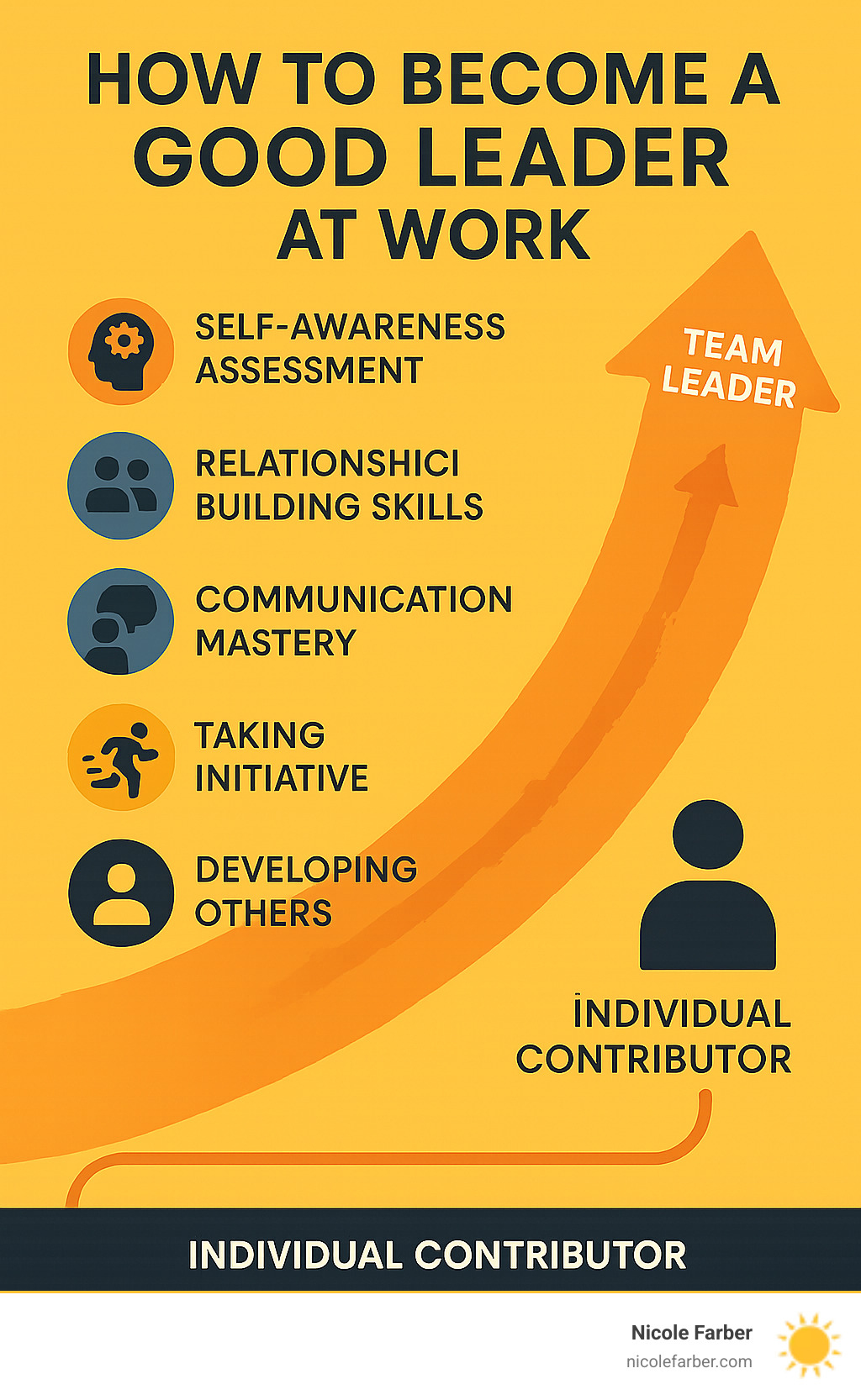Office Odyssey: Becoming the Leader Your Team Deserves
- Leadership
- In the News
- November 21, 2025
Why Leadership Excellence Matters More Than Ever

How to become a good leader at work starts with understanding that leadership isn’t about having the fanciest title or corner office. It’s about creating an environment where others can thrive, driving a collective vision, and influencing others positively.
Quick Answer: The 5 Essential Steps to Workplace Leadership
- Lead by example – Demonstrate the work ethic and values you expect from others
- Build strong relationships – Earn respect through trust, active listening, and genuine care
- Communicate clearly – Master both speaking and listening to create open dialogue
- Develop your strengths – Focus on leveraging natural talents rather than fixing weaknesses
- Take initiative – Volunteer for challenging projects and support your colleagues
The numbers tell a powerful story. Research shows that 95% of organizations are investing more in leadership development, and for good reason. Companies with engaged leaders see 65-68% higher employee engagement, while those with strong workplace relationships experience a 50% increase in employee satisfaction.
Whether you’re managing a legal team in Philadelphia, building a practice in Wilkes-Barre, or leading remote workers from New Orleans to Antigua Guatemala, the fundamentals remain the same. Great leaders aren’t born – they’re developed through intentional practice and continuous learning.
As Nicole Farber, CEO of ENX2 Legal Marketing with over 15 years of experience leading teams and turning around struggling businesses, I’ve seen how to become a good leader at work through both triumphs and challenges. My passion lies in helping others find their leadership potential and create positive change that ripples through their entire organization.

How to become a good leader at work definitions:
The Bedrock of Leadership: Understanding Core Qualities

Think of leadership like building a house. You can have the most beautiful design and the finest materials, but without a solid foundation, everything will eventually crumble. That’s exactly why understanding core leadership qualities is so crucial when learning how to become a good leader at work.
These aren’t just nice-to-have traits or corporate buzzwords. They’re the fundamental qualities that separate managers who simply oversee tasks from leaders who truly inspire and transform their teams. Whether you’re leading a legal team in Philadelphia or managing remote workers across the country, these bedrock qualities remain constant. For a deeper dive into these essential principles, check out our Business Leadership Ultimate Guide.
Know Thyself: The Power of Strengths-Based Leadership
Here’s something that might surprise you: the key to becoming a better leader isn’t necessarily fixing all your weaknesses. It’s about knowing and leveraging your natural strengths.
This insight comes from years of Gallup research on CliftonStrengths, and it completely flips traditional thinking on its head. Instead of spending endless hours trying to be mediocre at everything, what if you became exceptional at what you’re naturally good at?
The numbers are pretty incredible. People who focus on their strengths rather than their weaknesses are 6 times more likely to be engaged at work. They’re also more productive and experience higher overall life satisfaction. When you think about it, this makes perfect sense. We all have those tasks that energize us and those that drain us completely.
As a leader, when you operate from your strengths, you bring authentic energy and passion to your role. Your team feels it, and that enthusiasm becomes contagious. Plus, when you understand your own strengths, you become much better at recognizing and developing the unique talents in others.
If you’re curious about your own natural talents, I highly recommend you take the assessment today. It’s one of the most valuable investments you can make in your leadership journey.
The Leader’s Compass: Integrity, Empathy, and Vision
Every great leader needs a compass – something that guides their decisions and actions, especially when the path gets unclear. For leaders, that compass is built on three essential qualities: integrity, empathy, and vision.
Integrity is your foundation. It’s about being honest, keeping your word, and doing the right thing even when no one is watching. Without integrity, trust evaporates, and without trust, leadership becomes impossible. Your team needs to know that you’ll be consistent in your values and decisions.
Empathy and emotional intelligence are equally crucial. Here’s a fascinating statistic: research shows that emotional intelligence is valued more highly than IQ by managers. Why? Because leadership is fundamentally about people, and people have emotions, challenges, and dreams that go far beyond their job descriptions.
When you develop your emotional intelligence, you become skilled at reading the room, understanding what motivates each team member, and responding appropriately to different situations. Whether you’re working with a stressed attorney in Wilkes-Barre or celebrating a team win in New Orleans, emotional intelligence helps you connect authentically with your people.
Visionary thinking rounds out your leadership compass. This isn’t about having grand, unrealistic dreams. It’s about seeing beyond today’s tasks to tomorrow’s possibilities. Great leaders help their teams understand not just what they’re doing, but why it matters and where it’s leading.
For more practical insights on developing these qualities, explore our guide on Being a Good Leader in the Workplace.
Understanding Your Team: The Four Essential Needs of Followers
Here’s something I’ve learned through years of leadership experience: before you can effectively lead others, you need to understand what they truly need from you. Gallup’s research has identified four universal needs that every follower has, and meeting these needs is essential for creating psychological safety and building high-performing teams.
First, your team needs trust. They need to know you’ll keep your word, make fair decisions, and have their backs when things get tough. Trust isn’t built overnight – it’s earned through countless small actions and consistent behavior over time.
Second, they need compassion. Your team members aren’t just employees; they’re whole people with families, dreams, and challenges outside of work. When you show genuine care and concern for them as individuals, you create deeper connections and stronger loyalty.
Third, they crave stability. In our rapidly changing business world, people need to feel secure and know what to expect from their leader. This doesn’t mean avoiding all change, but rather providing consistent leadership and clear communication during uncertain times.
Finally, they need hope. Your team wants to believe that their work matters, that they’re growing, and that better days are ahead. As a leader, you’re often the person who helps them see possibilities they can’t see for themselves.
Whether you’re leading a team in Luzerne County or managing remote workers from Antigua Guatemala, these four needs remain constant. When you consistently meet these needs, you create an environment where people can do their best work and feel genuinely valued.
How to Become a Good Leader at Work: Actionable Daily Strategies

Understanding leadership qualities is wonderful, but knowing how to become a good leader at work means turning those insights into daily action. Real leadership happens in the small moments – the way you handle a difficult conversation, how you respond when things go wrong, and whether you choose to lift others up or focus only on yourself.
After years of building teams and turning around struggling businesses, I’ve learned that leadership isn’t about grand gestures. It’s about showing up consistently, day after day, in ways that earn respect and inspire others to do their best work. For more practical guidance, check out our comprehensive resource on How to Become an Effective Leader.
Lead by Example: The Ultimate Form of Influence
The most powerful leadership tool you have is your own behavior. People watch what you do far more than they listen to what you say. When you lead by example, you create a ripple effect that shapes your entire workplace culture.
Accountability starts with you. When you make a mistake, own it. When a project succeeds, share the credit. Taking responsibility for both your wins and losses shows your team that it’s safe to be human and that growth comes from learning, not from being perfect.
Following policies might seem basic, but it’s surprisingly powerful. When you arrive on time, follow the same procedures as everyone else, and respect company guidelines, you show that rules aren’t just for other people. Whether you’re managing a team in Philadelphia or leading a project in Wilkes-Barre, consistency in your standards builds trust.
Volunteering for tough tasks speaks volumes about your character. When there’s an unpleasant project or a challenging client situation, stepping up first demonstrates that you’re not above any work. This approach aligns with what we call Process Before Promotion – proving your commitment through action, not just words.
Your work ethic becomes the standard for your team. If you want people to be dedicated, punctual, and professional, you need to model those behaviors every single day. People rise to meet expectations, but only when those expectations are clearly demonstrated through your own actions.
Build Bridges, Not Walls: Fostering Strong Workplace Relationships
Strong workplace relationships aren’t just nice to have – they’re essential for team success. Research shows that employee satisfaction increases by 50% when people develop meaningful connections at work. This isn’t about being everyone’s best friend; it’s about creating an environment where people feel valued and connected.
Building rapport means taking genuine interest in your colleagues as whole people. Learn about their families, their goals, and what motivates them. When you understand what matters to someone, you can better support their success and well-being.
Open communication requires creating psychological safety where people feel comfortable sharing ideas, concerns, and even disagreements. Reward creativity and fresh thinking, even when ideas don’t work out perfectly. When team members know their input is valued, they’ll contribute more thoughtfully and enthusiastically.
Trustworthiness is built through countless small actions. Keep your promises. Be transparent about challenges. Share information when you can. When people trust you, they’re more willing to go the extra mile and support team goals.
Maintaining a positive attitude doesn’t mean ignoring problems or pretending everything is perfect. It means approaching challenges with optimism and resilience. Your energy affects everyone around you, whether you’re working with a legal team in New Orleans or managing remote workers across different time zones.
For deeper insights into workplace relationships and satisfaction, you can explore more on employee satisfaction.
Master the Art of Communication and Active Listening
Great leaders are great communicators, but that doesn’t mean they do all the talking. The best communicators spend more time listening than speaking, and they pay attention to both words and emotions.
Clear communication means expressing your thoughts in ways people can easily understand and act on. Skip the jargon and corporate speak. Whether you’re explaining a new process or sharing feedback, be direct and specific. Ambiguity creates confusion, and confusion kills productivity.
Active listening is perhaps the most underrated leadership skill. It means giving someone your complete attention – not thinking about your response while they’re talking, not checking your phone, not rushing them to finish. True listening involves understanding both the content of what someone is saying and the feelings behind it.
Pay attention to non-verbal cues and body language – both yours and theirs. Maintain good eye contact, keep an open posture, and make sure your body language matches your words. If you’re asking someone to take on an important project, look them in the eye and engage fully rather than staring at your computer screen.
Providing feedback effectively means being both honest and supportive. People need to know how they’re doing and where they can improve, but feedback should help them grow, not tear them down. Regular, constructive feedback prevents small issues from becoming big problems.
Fostering open dialogue means creating space for different perspectives and healthy debate. The best solutions often come from combining multiple viewpoints, and teams that can discuss disagreements respectfully are stronger and more innovative.
When you master these communication skills, you prevent misunderstandings, build stronger relationships, and create a culture where everyone feels heard and valued. That’s how to become a good leader at work – through consistent, authentic daily actions that show you care about both the work and the people doing it.
From Follower to Influencer: Developing Your Leadership Toolkit

The change from follower to leader doesn’t happen overnight. Learning how to become a good leader at work requires intentional skill development, continuous learning, and a commitment to growth that extends far beyond your current role. This evolution from individual contributor to influential leader is both exciting and challenging, requiring us to expand our toolkit and deepen our understanding of what it truly means to lead others.
Whether you’re building your leadership skills in a Philadelphia law firm or developing your influence in a Wilkes-Barre business, the principles remain consistent. Our Leadership Development Seminars are designed to support you through this transformative journey.
The 7 Core Expectations for Every Leader
Gallup’s research has identified seven essential competencies that distinguish exceptional leaders from the rest. These aren’t just nice-to-have qualities; they’re the foundation of effective leadership that drives real results.
Building relationships forms the cornerstone of everything we do as leaders. When we invest in authentic connections with our team members, peers, and stakeholders, we create the trust necessary for everything else to flourish. Developing people naturally follows, as we provide growth opportunities, offer meaningful feedback, and empower individuals to reach their full potential.
Leading change becomes crucial in today’s dynamic business environment. Great leaders don’t just manage transitions; they guide their teams through uncertainty while maintaining momentum and morale. This connects directly to our ability to inspire others through passion, vision, and genuine recognition of their contributions.
Thinking critically separates reactive managers from proactive leaders. We must analyze situations thoroughly, evaluate risks carefully, and make informed decisions that benefit the entire team. This critical thinking must be paired with our ability to communicate clearly, ensuring our messages resonate and drive understanding across all levels.
Finally, creating accountability ensures that expectations are clear, commitments are honored, and everyone takes ownership of their results. This isn’t about micromanaging; it’s about empowering people to succeed within a framework of mutual responsibility.
To assess your own development in these areas, you can Download Gallup’s 7 Expectations for Leaders activity and create a personalized growth plan.
How to create a leadership development plan to position yourself for promotion
Positioning yourself for promotion requires more than hoping someone notices your good work. It demands strategic planning and intentional skill development that demonstrates your readiness for greater responsibility.
Setting clear goals provides the roadmap for your leadership journey. These should be specific and measurable – perhaps improving your public speaking skills, mastering project management, or developing strategic thinking capabilities. Identifying skill gaps requires honest self-assessment, feedback from colleagues, and sometimes formal evaluations to understand where you need to grow.
Seeking mentorship can accelerate your development exponentially. Experienced leaders who’ve walked this path can offer invaluable guidance, share hard-won insights, and help you steer challenges you haven’t yet encountered. Continuous learning keeps you sharp and relevant, whether through books, podcasts, workshops, or online courses.
For professionals serious about advancing their leadership capabilities, furthering education through programs like an MBA or Master’s in Organizational Leadership can provide comprehensive frameworks for understanding complex business challenges. This is particularly valuable for leaders in regions like Luzerne County who want to bring cutting-edge practices to their local industries.
Creating this personal growth plan doesn’t just develop your skills – it demonstrates your commitment to leadership and makes you the obvious choice when promotion opportunities arise.
Leader vs. Manager: Understanding the Critical Difference
Understanding the distinction between leadership and management is crucial for anyone asking how to become a good leader at work. While both roles are important, they serve different functions and require different approaches.
| Feature | Manager | Leader |
|---|---|---|
| Primary Focus | Execution and efficiency | Vision and change |
| Approach | Organizing and supervising | Inspiring and coaching |
| Authority Source | Formal position and title | Influence and trust |
| Relationship Style | Transactional interactions | Changeal connections |
| Change Orientation | Maintaining stability | Driving innovation |
| Decision Making | Process-driven compliance | Values-driven judgment |
The impact of this difference is significant. Gallup’s research reveals that 70% of team engagement variance is influenced by the manager. However, when that manager operates as a true leader – focusing on inspiration rather than just supervision – the results are dramatically different.
Managers tend to focus on maintaining systems and ensuring tasks get completed efficiently. Leaders, on the other hand, paint a compelling picture of the future and inspire people to work toward that vision. While a manager might say “Here’s what needs to be done,” a leader asks “Here’s why this matters and how we can achieve something meaningful together.”
The most effective professionals learn to blend both approaches, knowing when to manage processes and when to lead people. Whether you’re in New Orleans building a new practice or in Antigua Guatemala expanding internationally, this balance becomes essential for sustainable success.
This understanding helps us recognize that leadership isn’t about climbing the corporate ladder – it’s about expanding our influence and impact regardless of our formal title.